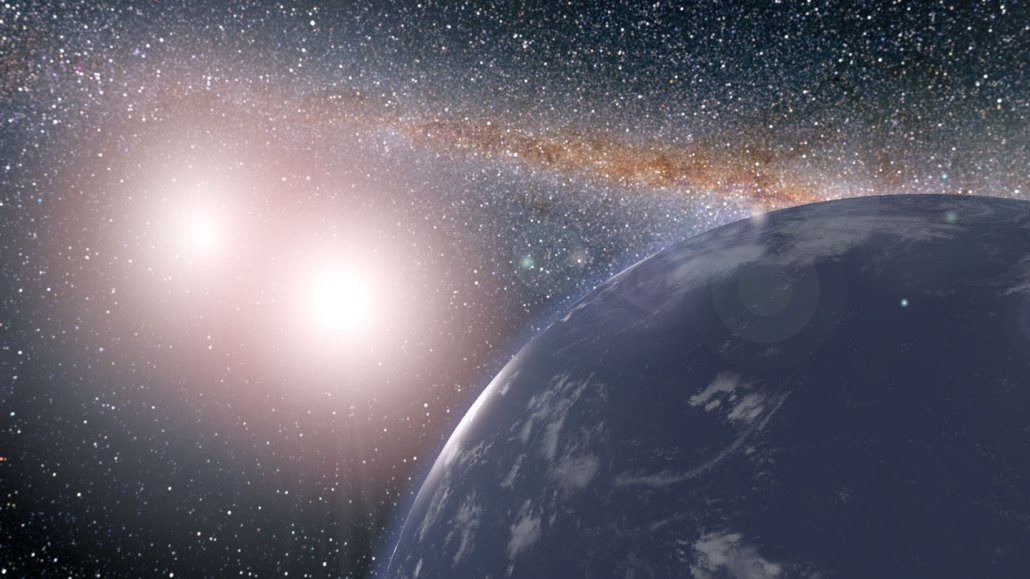Planets like Star Wars’ Tatooine could be fit for life
Like Luke Skywalker’s home, many habitable planets in the universe may have two suns

An artist's impression of a world that may exist in the Kepler-35 system. It orbits two suns. Such places could provide cozy solar systems for Earthlike planets.
JPL-Caltech/NASA
Share this:
- Share via email (Opens in new window) Email
- Click to share on Facebook (Opens in new window) Facebook
- Click to share on X (Opens in new window) X
- Click to share on Pinterest (Opens in new window) Pinterest
- Click to share on Reddit (Opens in new window) Reddit
- Share to Google Classroom (Opens in new window) Google Classroom
- Click to print (Opens in new window) Print
SEATTLE, Wash. — Luke Skywalker’s home planet in Star Wars is the stuff of science fiction. Called Tatooine, the planet orbits two stars. A new study suggests similar planets might be the best focus in the search for places that can host life outside our solar system.
Many suns come in pairs called binary stars. Lots of these should have planets orbiting them. That means there could be more planets orbiting around binary stars than around lone stars like our sun. But until now, no one had a clear idea about whether those planets could sustain life. New computer models suggest that in many cases life could imitate Star Wars.
Earthlike planets orbiting some binary stars can stay in stable orbits for at least a billion years. Researchers shared their finding in Seattle, January 11, at the American Astronomical Society meeting. That sort of stability could potentially allow life to develop, as long as the planets aren’t too hot or too cold.
The researchers ran computer models of binary stars arranged in thousands of ways. Each had an Earthlike planet orbiting the two stars. The team varied things like how massive the stars were compared to each other. They modeled different sizes and shapes of the stars’ orbit around each other. And they also looked at the size of the planet’s orbit around each star pair.
The scientists then tracked the motion of the planets for up to a billion years of simulated time. That revealed whether the planets would stay in orbit over timescales that might allow life to emerge.
They also checked to see if the planets stayed in a habitable zone. That’s the region around a star where an orbiting planet’s temperatures are never extremely hot or cold, and water could stay liquid.
The team made models for 4,000 sets of planets and stars. Of those, roughly 500 had stable orbits that kept planets in their habitable zones 80 percent of the time.
Going steady
A planet orbiting binary stars can get kicked out of its solar system. The gravity of each star and the planet affect the planet’s orbit. That can create complicated interactions that push out the planet. In the new work, the researchers found that only about one out of every eight such planets was kicked out of its system. The rest were stable enough to orbit for the full billion years. About one in 10 settled into their habitable zones and stayed there.
The team defined the habitable zone as spanning the temperatures at which water freezes and boils, says Michael Pedowitz. He’s an undergraduate student at the College of New Jersey in Ewing who presented the research. That choice allowed the team to model Earthlike planets without atmospheres or oceans. This made their task easier. It also meant that temperatures could swing wildly on a planet through its orbit.
An atmosphere and oceans could smooth out some of those temperature variations, says Mariah MacDonald. She’s an astrobiologist at the College of New Jersey. She, too, took part in the new modeling work. An abundance of air and water could change the picture. It might maintain the conditions for life even if a planet strayed from the typical habitable zone. Adding atmospheres to the modeled planets should increase the number that could host life, she concludes.
She and Pedowitz hope to build more advanced models in coming months. They also want to project them out longer than a billion years. And they’d like to include changes in the stars that can affect conditions as a solar system ages.
Models of planets orbiting binary stars could guide future efforts to look for them with telescopes says Jason Wright. An astrophysicist, he studies the physics of stars at Pennsylvania State University in University Park. He was not involved in the new study. “This is an under-explored population of planets. There’s no reason we can’t go after them,” he says. And, he adds, it might be worthwhile to try.
“At the time Star Wars came out,” Wright says, “we didn’t know of any planets outside the solar system — and wouldn’t for 15 years. Now we know that there are many and that they orbit these binary stars.”







